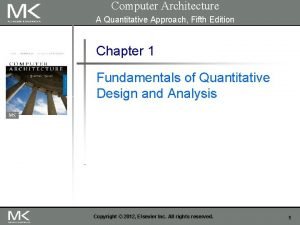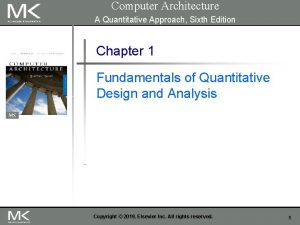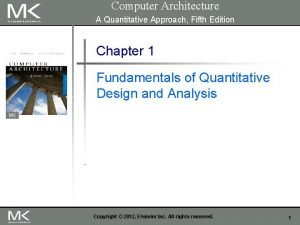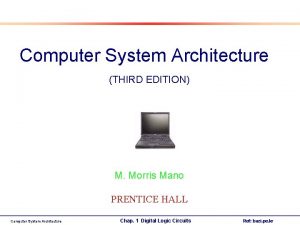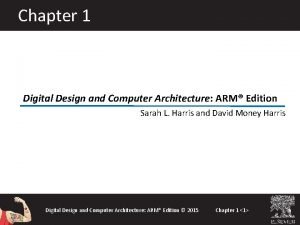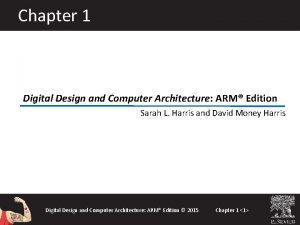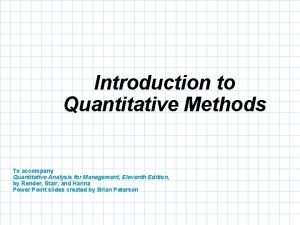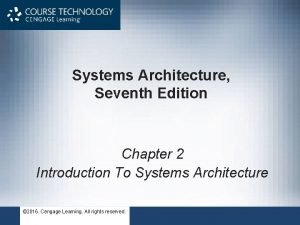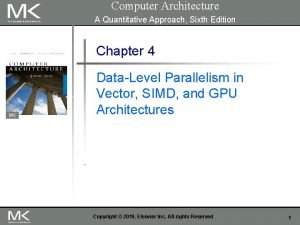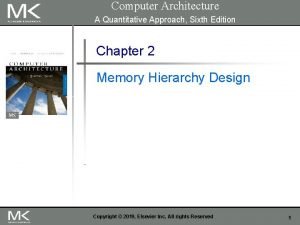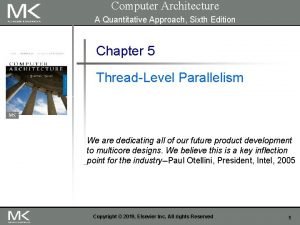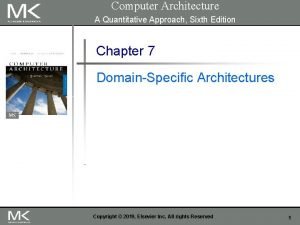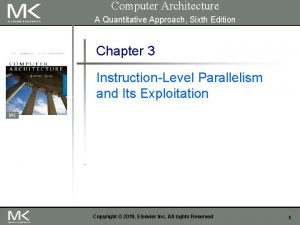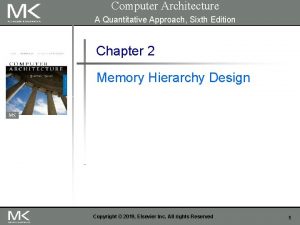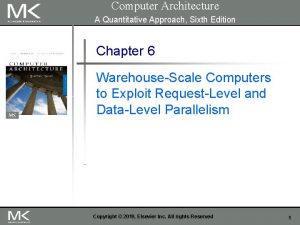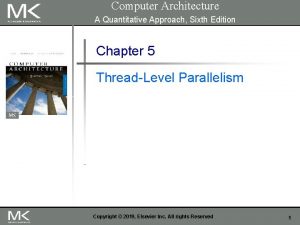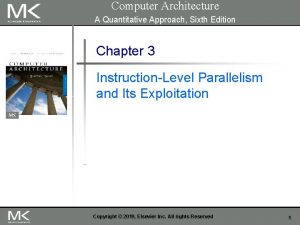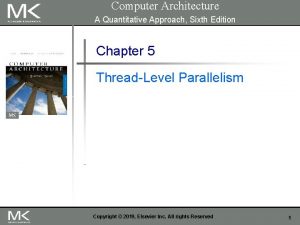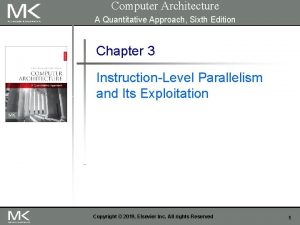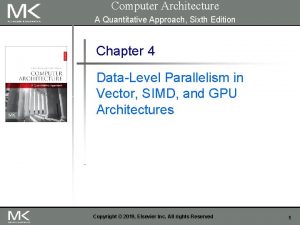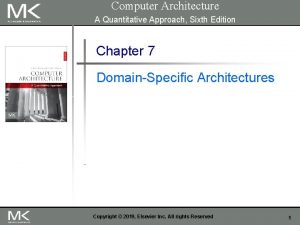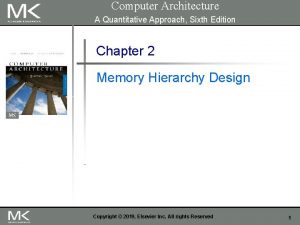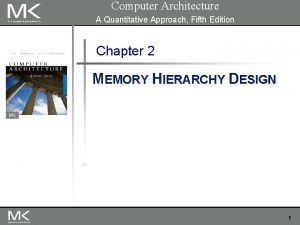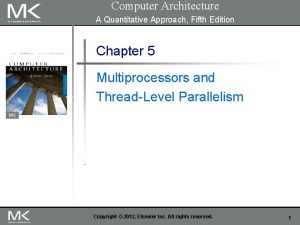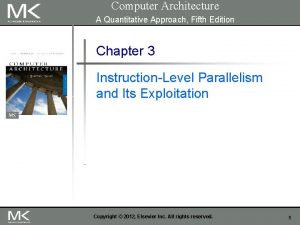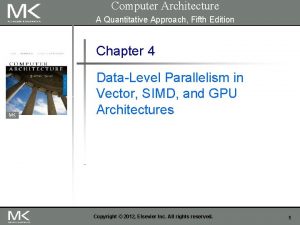Computer Architecture A Quantitative Approach Sixth Edition Chapter































- Slides: 31

Computer Architecture A Quantitative Approach, Sixth Edition Chapter 1 Fundamentals of Quantitative Design and Analysis Copyright © 2019, Elsevier Inc. All rights reserved. 1

n Performance improvements: n Improvements in semiconductor technology n n Feature size, clock speed Improvements in computer architectures n n n Introduction Computer Technology Enabled by HLL compilers, UNIX Lead to RISC architectures Together have enabled: n n Lightweight computers Productivity-based managed/interpreted programming languages Copyright © 2019, Elsevier Inc. All rights reserved. 2

Copyright © 2019, Elsevier Inc. All rights reserved. Introduction Single Processor Performance 3

n Cannot continue to leverage Instruction-Level parallelism (ILP) n n Single processor performance improvement ended in 2003 New models for performance: n n Introduction Current Trends in Architecture Data-level parallelism (DLP) Thread-level parallelism (TLP) Request-level parallelism (RLP) These require explicit restructuring of the application Copyright © 2019, Elsevier Inc. All rights reserved. 4

n Personal Mobile Device (PMD) n n n Desktop Computing n n Emphasis on availability, scalability, throughput Clusters / Warehouse Scale Computers n n Emphasis on price-performance Servers n n e. g. start phones, tablet computers Emphasis on energy efficiency and real-time Classes of Computers Used for “Software as a Service (Saa. S)” Emphasis on availability and price-performance Sub-class: Supercomputers, emphasis: floating-point performance and fast internal networks Internet of Things/Embedded Computers n Emphasis: price Copyright © 2019, Elsevier Inc. All rights reserved. 5

n Classes of parallelism in applications: n n n Data-Level Parallelism (DLP) Task-Level Parallelism (TLP) Classes of Computers Parallelism Classes of architectural parallelism: n n Instruction-Level Parallelism (ILP) Vector architectures/Graphic Processor Units (GPUs) Thread-Level Parallelism Request-Level Parallelism Copyright © 2019, Elsevier Inc. All rights reserved. 6

n Single instruction stream, single data stream (SISD) n Single instruction stream, multiple data streams (SIMD) n n Vector architectures Multimedia extensions Graphics processor units Multiple instruction streams, single data stream (MISD) n n Classes of Computers Flynn’s Taxonomy No commercial implementation Multiple instruction streams, multiple data streams (MIMD) n n Tightly-coupled MIMD Loosely-coupled MIMD Copyright © 2019, Elsevier Inc. All rights reserved. 7

n “Old” view of computer architecture: n n Instruction Set Architecture (ISA) design i. e. decisions regarding: n n registers, memory addressing, addressing modes, instruction operands, available operations, control flow instructions, instruction encoding Defining Computer Architecture “Real” computer architecture: n n n Specific requirements of the target machine Design to maximize performance within constraints: cost, power, and availability Includes ISA, microarchitecture, hardware Copyright © 2019, Elsevier Inc. All rights reserved. 8

n Class of ISA n n n General-purpose registers Register-memory vs load-store RISC-V registers n 32 g. p. , 32 f. p. Register Name Use Saver x 9 s 1 saved callee Register Name Use Saver x 10 -x 17 a 0 -a 7 arguments caller x 0 zero constant 0 n/a x 18 -x 27 s 2 -s 11 saved callee x 1 ra return addr caller x 28 -x 31 t 3 -t 6 temporaries caller x 2 sp stack ptr callee f 0 -f 7 ft 0 -ft 7 FP temps caller x 3 gp gbl ptr f 8 -f 9 fs 0 -fs 1 FP saved callee x 4 tp thread ptr f 10 -f 17 fa 0 -fa 7 FP arguments callee x 5 -x 7 t 0 -t 2 temporaries caller x 8 s 0/fp saved/ frame ptr callee f 18 -f 27 fs 2 -fs 21 FP saved callee f 28 -f 31 ft 8 -ft 11 FP temps caller Copyright © 2019, Elsevier Inc. All rights reserved. Defining Computer Architecture Instruction Set Architecture 9

n Memory addressing n n Addressing modes n n n RISC-V: byte addressed, aligned accesses faster RISC-V: Register, immediate, displacement (base+offset) Other examples: autoincrement, indexed, PC-relative Defining Computer Architecture Instruction Set Architecture Types and size of operands n RISC-V: 8 -bit, 32 -bit, 64 -bit Copyright © 2019, Elsevier Inc. All rights reserved. 10

Defining Computer Architecture Instruction Set Architecture n Operations n n n Control flow instructions n n n RISC-V: data transfer, arithmetic, logical, control, floating point See Fig. 1. 5 in text Use content of registers (RISC-V) vs. status bits (x 86, ARMv 7, ARMv 8) Return address in register (RISC-V, ARMv 7, ARMv 8) vs. on stack (x 86) Encoding n Fixed (RISC-V, ARMv 7/v 8 except compact instruction set) vs. variable length (x 86) Copyright © 2019, Elsevier Inc. All rights reserved. 11

Trends in Technology n Integrated circuit technology (Moore’s Law) n n DRAM capacity: 25 -40%/year (slowing) n n 8 Gb (2014), 16 Gb (2019), possibly no 32 Gb Flash capacity: 50 -60%/year n n Transistor density: 35%/year Die size: 10 -20%/year Integration overall: 40 -55%/year 8 -10 X cheaper/bit than DRAM Magnetic disk capacity: recently slowed to 5%/year n n n Density increases may no longer be possible, maybe increase from 7 to 9 platters 8 -10 X cheaper/bit then Flash 200 -300 X cheaper/bit than DRAM Copyright © 2019, Elsevier Inc. All rights reserved. 12

n Bandwidth or throughput n n Total work done in a given time 32, 000 -40, 000 X improvement for processors 300 -1200 X improvement for memory and disks Trends in Technology Bandwidth and Latency or response time n n n Time between start and completion of an event 50 -90 X improvement for processors 6 -8 X improvement for memory and disks Copyright © 2019, Elsevier Inc. All rights reserved. 13

Trends in Technology Bandwidth and Latency Log-log plot of bandwidth and latency milestones Copyright © 2019, Elsevier Inc. All rights reserved. 14

n Feature size n n n Minimum size of transistor or wire in x or y dimension 10 microns in 1971 to. 011 microns in 2017 Transistor performance scales linearly n n Trends in Technology Transistors and Wires Wire delay does not improve with feature size! Integration density scales quadratically Copyright © 2019, Elsevier Inc. All rights reserved. 15

n Problem: Get power in, get power out n Thermal Design Power (TDP) n n n Characterizes sustained power consumption Used as target for power supply and cooling system Lower than peak power (1. 5 X higher), higher than average power consumption Trends in Power and Energy Clock rate can be reduced dynamically to limit power consumption Energy per task is often a better measurement Copyright © 2019, Elsevier Inc. All rights reserved. 16

n Dynamic energy n n n Dynamic power n n Transistor switch from 0 -> 1 or 1 -> 0 ½ x Capacitive load x Voltage 2 Trends in Power and Energy Dynamic Energy and Power ½ x Capacitive load x Voltage 2 x Frequency switched Reducing clock rate reduces power, not energy Copyright © 2019, Elsevier Inc. All rights reserved. 17

n n Intel 80386 consumed ~ 2 W 3. 3 GHz Intel Core i 7 consumes 130 W Heat must be dissipated from 1. 5 x 1. 5 cm chip This is the limit of what can be cooled by air Copyright © 2019, Elsevier Inc. All rights reserved. Trends in Power and Energy Power 18

n Techniques for reducing power: n n Do nothing well Dynamic Voltage-Frequency Scaling Trends in Power and Energy Reducing Power Low power state for DRAM, disks Overclocking, turning off cores Copyright © 2019, Elsevier Inc. All rights reserved. 19

n Static power consumption n n 25 -50% of total power Currentstatic x Voltage Scales with number of transistors To reduce: power gating Copyright © 2019, Elsevier Inc. All rights reserved. Trends in Power and Energy Static Power 20

n Cost driven down by learning curve n n n Trends in Cost Yield DRAM: price closely tracks cost Microprocessors: price depends on volume n 10% less for each doubling of volume Copyright © 2019, Elsevier Inc. All rights reserved. 21

n Integrated circuit n Bose-Einstein formula: n n Trends in Cost Integrated Circuit Cost Defects per unit area = 0. 016 -0. 057 defects per square cm (2010) N = process-complexity factor = 11. 5 -15. 5 (40 nm, 2010) Copyright © 2019, Elsevier Inc. All rights reserved. 22

Dependability n Module reliability n n Mean time to failure (MTTF) Mean time to repair (MTTR) Mean time between failures (MTBF) = MTTF + MTTR Availability = MTTF / MTBF Copyright © 2019, Elsevier Inc. All rights reserved. 23

n Typical performance metrics: n n n Speedup of X relative to Y n n Execution time. Y / Execution time. X Execution time n n n Response time Throughput Measuring Performance Wall clock time: includes all system overheads CPU time: only computation time Benchmarks n n Kernels (e. g. matrix multiply) Toy programs (e. g. sorting) Synthetic benchmarks (e. g. Dhrystone) Benchmark suites (e. g. SPEC 06 fp, TPC-C) Copyright © 2019, Elsevier Inc. All rights reserved. 24

n Take Advantage of Parallelism n n e. g. multiple processors, disks, memory banks, pipelining, multiple functional units Principle of Locality n n Principles of Computer Design Reuse of data and instructions Focus on the Common Case n Amdahl’s Law Copyright © 2019, Elsevier Inc. All rights reserved. 25

n Principles of Computer Design The Processor Performance Equation Copyright © 2019, Elsevier Inc. All rights reserved. 26

n Principles of Computer Design Different instruction types having different CPIs Copyright © 2019, Elsevier Inc. All rights reserved. 27

n Principles of Computer Design Different instruction types having different CPIs Copyright © 2019, Elsevier Inc. All rights reserved. 28

Fallacies and Pitfalls n All exponential laws must come to an end n Dennard scaling (constant power density) n n Disk capacity n n Stopped by threshold voltage 30 -100% per year to 5% per year Moore’s Law n n Most visible with DRAM capacity ITRS disbanded Only four foundries left producing state-of-the-art logic chips 11 nm, 3 nm might be the limit Copyright © 2019, Elsevier Inc. All rights reserved. 29

Fallacies and Pitfalls n Microprocessors are a silver bullet n n n Performance is now a programmer’s burden Falling prey to Amdahl’s Law A single point of failure Hardware enhancements that increase performance also improve energy efficiency, or are at worst energy neutral Benchmarks remain valid indefinitely n Compiler optimizations target benchmarks Copyright © 2019, Elsevier Inc. All rights reserved. 30

Fallacies and Pitfalls n The rated mean time to failure of disks is 1, 200, 000 hours or almost 140 years, so disks practically never fail n n n MTTF value from manufacturers assume regular replacement Peak performance tracks observed performance Fault detection can lower availability n Not all operations are needed for correct execution Copyright © 2019, Elsevier Inc. All rights reserved. 31
 Computer architecture a quantitative approach sixth edition
Computer architecture a quantitative approach sixth edition Computer architecture a quantitative approach 6th
Computer architecture a quantitative approach 6th Computer architecture a quantitative approach sixth edition
Computer architecture a quantitative approach sixth edition Computer architecture 5th edition
Computer architecture 5th edition Computer architecture a quantitative approach
Computer architecture a quantitative approach Computer architecture a quantitative approach
Computer architecture a quantitative approach Mmodation
Mmodation Rubber baby buggy bumpers tongue twister lyrics
Rubber baby buggy bumpers tongue twister lyrics Biochemistry sixth edition
Biochemistry sixth edition Automotive technology principles diagnosis and service
Automotive technology principles diagnosis and service Automotive technology sixth edition
Automotive technology sixth edition Citation sample pdf
Citation sample pdf Precalculus sixth edition
Precalculus sixth edition Principles of economics sixth edition
Principles of economics sixth edition Digital design and computer architecture arm edition
Digital design and computer architecture arm edition Computer system architecture m morris mano
Computer system architecture m morris mano Computer organization and architecture 10th edition
Computer organization and architecture 10th edition Computer architecture arm edition
Computer architecture arm edition Digital design and computer architecture arm edition
Digital design and computer architecture arm edition Bus architecture in computer architecture
Bus architecture in computer architecture Computer architecture vs computer organization
Computer architecture vs computer organization Basic computer organisation and design
Basic computer organisation and design Mis chapter 6
Mis chapter 6 Report
Report Define the concept of comparative education
Define the concept of comparative education Define quantitative analysis
Define quantitative analysis Quantitative approach to management
Quantitative approach to management The sixth extinction chapter 3 summary
The sixth extinction chapter 3 summary Cognitive theory child development
Cognitive theory child development Democritus atomic model diagram
Democritus atomic model diagram Types of system architecture
Types of system architecture Virtual circuit tables
Virtual circuit tables



